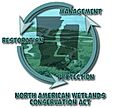North American Wetlands Conservation Act facts for kids
The North American Wetlands Conservation Act (P.L. 101-233), started on December 13, 1989, is a special program. It helps protect and manage wetlands, which are important watery habitats. This program gives money (grants) to projects that save wetland homes for migratory birds and other wetland animals in the United States, Mexico, and Canada. A group of nine people meets regularly to decide which projects get the money.
This program encourages groups to work together. Both private companies and government groups team up to share costs. Between 50% and 70% of the money must go to projects in Mexico and Canada. Also, no more than half of the U.S. share for these countries can come from the government. This Act was updated in 2007 (P.L. 107-308). It plans to increase funding to $75 million in its final year.
Contents
How the Act Helps Wetlands
The Wetlands Conservation Act has done a lot of good for North America. It has found many ways to protect wetlands. This makes sure that homes for wildlife and migratory birds are safe. More than 2,000 projects have started. They work with 3,000 other groups. These groups include private and public landowners. Over 25 million acres in the United States have been helped.
Over $411 million from the government has led to $3.5 billion in total funding. This also creates jobs through NAWCA. These jobs bring in $200 million in worker's earnings each year.
Why Wetlands Are Important
Plants and soils in wetlands are very important for the environment. They clean water by taking out high levels of nitrogen and phosphorus. They also remove harmful chemicals before they can get into the groundwater. When wetland plants and soils are healthy, many bad toxins are kept out. This makes the whole habitat a safer place for migratory birds and other animals to live.
NAWCA helps wildlife and migratory birds. But it also helps people! When wetlands have lots of wildlife, humans can enjoy fishing, hunting, and nature.
NAWCA Projects Across States
Louisiana Wetlands
Louisiana has 47 NAWCA projects. These projects have protected 519,038 acres of wildlife habitat. NAWCA also has 19 projects that work across several states in Louisiana. These have saved 314,887 acres of wildlife habitat.
Louisiana has the most coastal wetlands in North America. But it also loses the most marshland. Louisiana loses 16,000-22,000 acres every year. Nearly 1,500 square miles of marsh have been lost over seven years.
Black Lake Terracing Project
The Black Lake Terracing Project is led by Ducks Unlimited. It includes 16 partnerships from other states, federal groups, non-profits, and private partners. This project has brought back marshes in many areas. This includes areas west of Hackberry, Louisiana near Black Lake. It also includes areas on the Cameron Prairie National Wildlife Refuge.
The Black Lake Terracing Project focuses on areas that are homes for migrating and wintering birds. These birds include scaup, mottled ducks, northern pintails, and mallards. The homes and lives of shorebirds, wading birds, and other water-birds are also very important in this project.
Mississippi Wetlands
Theodore Roosevelt National Wildlife Refuge Complex
This Mississippi project has protected over 675 acres of wetland. These areas include Morgan Brake National Wildlife Refuge and Panther Swamp National Wildlife Refuge. In Morgan Brake's wildlife area, NAWCA has changed empty crawfish ponds into moist soil units. To do this, wells and underground irrigation were improved. Also, levees (raised banks) in the area were redesigned.
The work on Panther Swamp has made the waterfowl habitat better in the Lower Twist and Big Twist areas. By improving and building new levees, refuge staff can better control flooding. This helps moist soil plants and farm crops grow for waterfowl. In 2009, Panther Swamp opened 800 acres that were once closed. This allowed people to hunt in that area again.
The Theodore Roosevelt National Wildlife Refuge Complex has worked with many groups. These include Ducks Unlimited, Wetlands America Trust, Environmental Synergy, the Walker Foundation, and the U.S. Fish and Wildlife Service.
Arkansas Wetlands
Bayou Meto Basin Phase I
NAWCA is working on 14 projects in the Arkansas area. Over 67,414 acres of land have been saved. $8.7 million has been given to these projects. Partners have added $33.5 million. Arkansas has 12 multi-state projects happening. The 294,710 acres covered are in better shape than ever before.
Halowell reservoir is in Arkansas County. It was built in the 1950s as a place for public hunting. From 1960-76, it was used for fishing. In the late 1960s, the reservoir was flooded. Later, the site was drained to control water better and build levees.
Recently, the site has become a waterfowl rest area. But there have been problems making it a good habitat. Small trees, broomsedges, and asters have grown everywhere. This has made it hard for waterfowls to enjoy the area.
Other Programs Like NAWCA
The North American Wetlands Conservation Act had a very good impact on wetlands. Because of its success, a similar act was written in 1990. This act was for wetlands and upland habitats (higher ground).
The Standard Grants Program
This program is called The Standard Grants Program. It is a competitive program that gives matching grants. It helps Canada, Mexico, and the United States with private and public wetland projects. These wetland projects must protect, restore, or improve wetlands for a long time. Projects in Mexico can also include training, environmental education, and helping organizations grow.
The Small Grants Program
The other program created was The Small Grants Program of 1996. This program is similar to The Standard Grants Program. However, its projects are usually smaller and do not need as much money. Grant requests for this program must not be more than $75,000.
Images for kids


